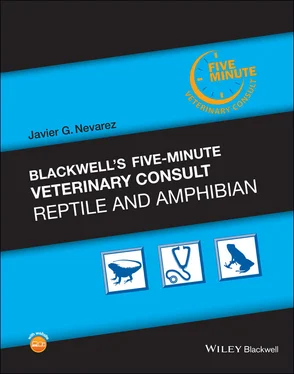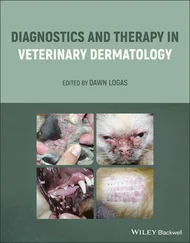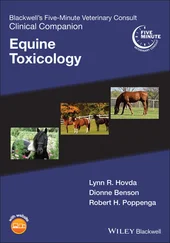Meloxicam 0.5 mg/kg PO, IM, SC q24–48h.
There is scant information about the safety and efficacy of oxytocin and arginine vasotocin when used for prolonged periods over 2–3 days.
Intravenous administration of both these drugs should be done slowly as they can cause life‐threatening hypotension.
Beta‐adrenergic blockers also may cause bradycardia and hypotension.
 FOLLOW‐UP
FOLLOW‐UP
PATIENT MONITORING
If performing medical therapy alone, especially with oxytocin or arginine vasotocin, the animals should be monitored closely to identify any signs of distress, although this is a rare occurrence.
If an underlying disease process was diagnosed, appropriate follow‐up diagnostics should be performed to determine improvement of that condition or the need to alter therapy.
For those undergoing surgery, a re‐evaluation within 1–2 weeks is recommended to evaluate the surgical site and overall recovery.
EXPECTED COURSE AND PROGNOSIS
Ultimately, the prognosis will depend on the underlying cause of dystocia and the response to therapy.
Cases with underlying infectious or metabolic disease that respond to medical therapy have a good prognosis.
Many cases requiring surgical therapy have a good to guarded prognosis.
 MISCELLANEOUS
MISCELLANEOUS
COMMENTS
The ultimate diagnosis of dystocia is based on interpretation of clinical signs, history, and results of physical exam and diagnostics.
In all cases, it is essential to have at least one confirmatory test that there are indeed eggs present in the coelomic cavity.
It must be mentioned that the sex of the animals must be confirmed as female before surgery is performed.
While this may seem obvious, in some chelonians, sex determination can be quite challenging and males may present with coelomic neoplasias or GI obstructions that clinically appear very similar to dystocia.
N/A
Egg bound
Postovulatory follicular stasis ABBREVIATIONS
Ca = calcium
CBC = complete blood count
CT scan = computed tomography
GI = gastrointestinal
ICe = intracoelomic
IM = intramuscular
IO = intraosseous
IV = intravenous
Mg = magnesium
MRI = magnetic resonance imaging
NSHP = nutritional secondary hyperparathyroidism
P = phosphorus
PO = per os
SC = subcutaneous
UVB = ultraviolet B
1 Chitty J, Raftery A. Egg retention/dystocia. In: Chitty J, Raftery A, eds. Essentials of Tortoise Medicine and Surgery. Oxford, UK: Wiley Blackwell; 2003:195–197.
2 Hochleithner C, Holland M. Ultrasonography. In: Mader DR, Divers SJ, eds. Current Therapy in Reptile Medicine and Surgery. St. Louis, MO: Elsevier Saunders; 2014:107–127.
3 Jacobson ER. Overview of reptile biology, anatomy, and histology. In: Jacobson ER, ed. Infectious Diseases and Pathology of Reptiles: Color Atlas and Text. Boca Raton, FL: CRC Press; 2007:14–17.
4 McArthur S. Problem‐solving approach to common diseases of terrestrial and semi‐aquatic chelonians. In: McArthur S, Wilkinson R, Meyer J, eds. Medicine and Surgery of Turtles and Tortoises. Ames, IA: Blackwell; 2004:309–378.
AuthorJavier G. Nevarez, DVM, PhD, DACZM, DECZM (Herpetology)
Egg Yolk Coelomitis
 BASICS
BASICS
DEFINITION/OVERVIEW
Egg yolk coelomitis occurs when yolk material is released into the coelomic cavity as a result of a ruptured follicle or egg due to oophoritis, follicular stasis, dystocia, salpingitis, or aggressive palpation.
In all cases, yolk coelomitis is a result of yolk material free within the coelomic cavity overwhelming the body’s activity to resorb the material. This leads to an intense inflammatory response that is often sterile but can also be associated with secondary bacterial infection.
It can progress to adhesions throughout the coelomic cavity, septicemia, and death.
Egg yolk coelomitis occurs in female chelonians of reproductive age or size, usually older than 1 year.
Most animals have a history of inadequate husbandry, being housed alone without access to a male, and lacking an appropriate area for laying eggs or giving birth.
The majority of cases occur in captive animals, but the author has diagnosed yolk coelomitis in free‐ranging gopher tortoises (Gopherus polyphemus).
Chelonians with yolk coelomitis often present with non‐specific clinical signs such as anorexia and lethargy.
Other abnormalities identified in physical exam may include hind‐limb weakness/ paresis, dehydration, poor body condition score, and pliable bones.
Some animals may present obtunded due to rapid progression of the disease.
Any factors that may result in follicular stasis or dystocia are also contributing factors to yolk coelomitis.
These include inadequate husbandry, nutrition, brumation, and nesting environment.
A less discussed topic is the effect that lack of exposure to males may have on the reproductive cycle of reptiles.
Many reptiles display courtship and breeding behaviors that likely influence the proper hormonal stimulation of prospective females.
Many female chelonians in captivity are kept alone without the benefit of behavioral cues from a male counterpart.
This possibility of a behavioral effect must be considered, especially when animals are maintained in proper husbandry and are otherwise healthy.
 DIAGNOSIS
DIAGNOSIS
DIFFERENTIAL DIAGNOSIS
Follicular stasis
Dystocia
Neoplasia
Ovarian cysts
GI obstruction
Septicemia
Evaluation of free fluid in the coelomic cavity will be a confirmatory test of yolk coelomitis. In acute cases, fluid is yellow to white, with a high amount of proteinaceous material and inflammatory cells.
In chronic cases the fluid may appear cloudier.
Blood and bacteria may also be observed with either presentation.
Radiography: findings may include free fluid, follicles, or ruptured eggs.
Ultrasound: aspiration of any free fluid can be used to diagnose egg yolk coelomitis.
CT scan and MRI: both modalities are extremely sensitive for evaluation of the reproductive tract. They can also help to assess damage to other organs.
Coelioscopic examination allows for confirmation of yolk coelomitis but may be confounded by changes in anatomy due to adhesions.
Читать дальше

 FOLLOW‐UP
FOLLOW‐UP MISCELLANEOUS
MISCELLANEOUS BASICS
BASICS DIAGNOSIS
DIAGNOSIS










